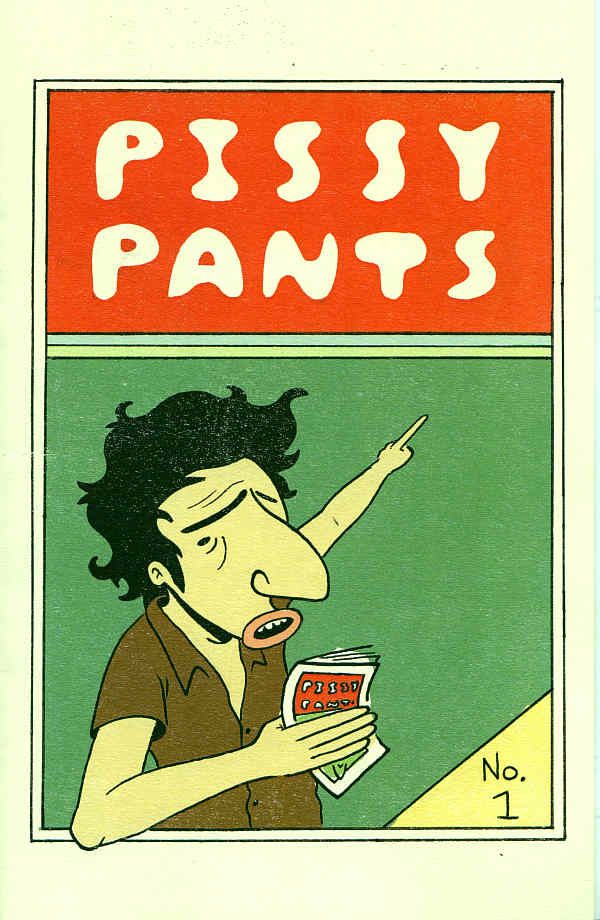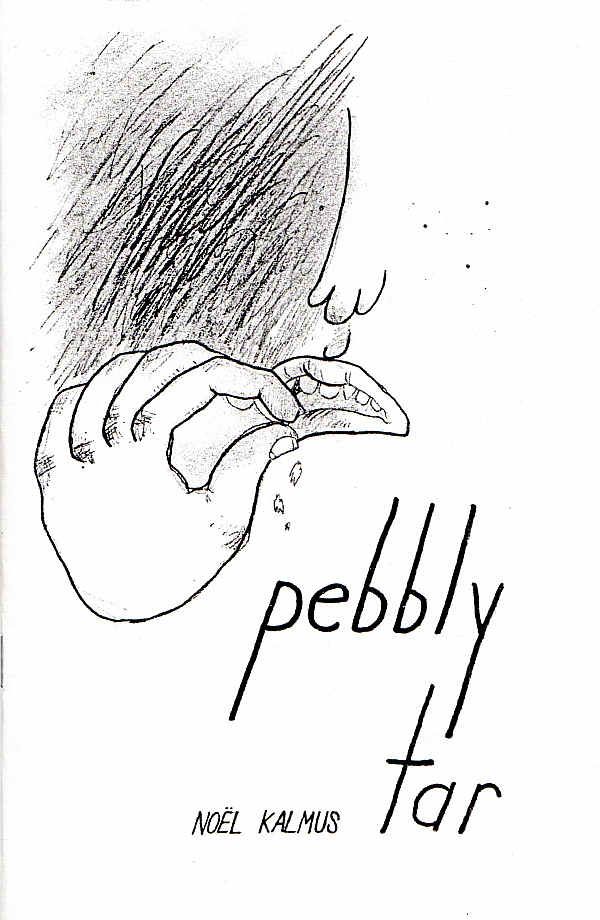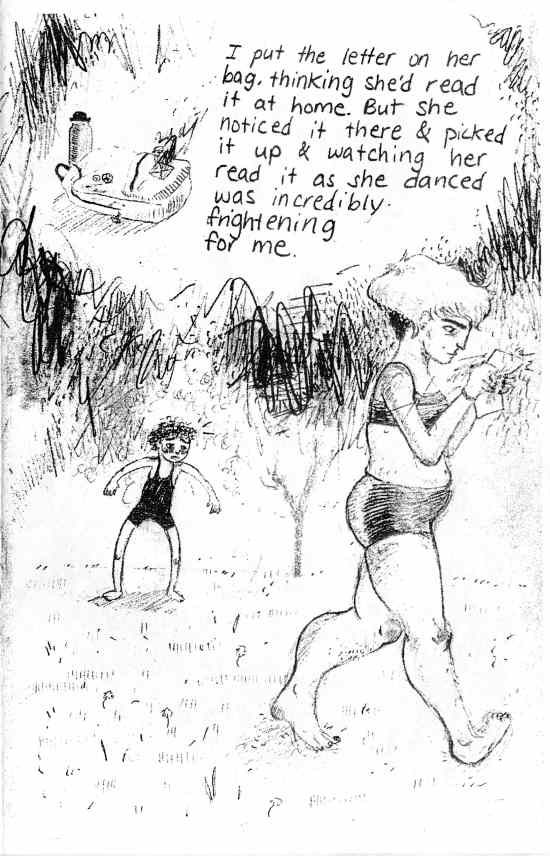I have been deluged with comics lately--the ones I picked up at Nighthawks at the Last Supper, some that I bought at the great Brooklyn comic shop, Rocketship on my brief New York vacation, several that I got via my support of them on Kickstarter campaigns, a few sent to me by generous publishers, and a handful purchased at Austin Books & Comics when I was in Austin recently. As long-time readers know, my coverage of comics on this blog is in terms of comics-as-art as opposed to comics-as-entertainment or comics-as-popular-culture. So here are some brief reviews of some of the art comics that I've read recently. (And more will follow shortly.)

cover of Pissy Pants by Brendan Kiefer
Pissy Pants by Brendan Kiefer. Pissy Pants is a comic I picked up at Nighthawks at the Last Supper (which I'm going to abbreviate as NLS from now on). It has a story--two stories, in a way--that it tells in its brief 16 pages. The first story is the artists addressing the reader, discussing what it means to be an artist and wanting success. Intertwined is a story that the artists is telling us--a cliched supernatural adventure story about a house at the bottom of a lake filled treasure--and danger! Neither story comes to a concrete conclusion, but you are left feeling that the character of Brendan abandons the adventure story out of fear of selling out. Pissy Pants is a minor work, but it's amusing and drawn in a humorous, minimal style.
Here's something weird about Pissy Pants. I pinned its cover to my "Comics" board in Pinterest and it got seven repins. That's quite a lot for one of my pins. It seems to be an image that a lot of people find compelling. (Pissy Pants can be purchased here.)

Noël Kalmus, cover of Pebbly Tar, 2012
Pebbly Tar by Noël Kalmus. Pebby Tar is another NLS mini-comic. The story is 13 pages long, with most pages having but a single illustration or moment of time on it. There are no panels or word-balloons. But it is a comics story. The protagonist has some kind of dark revelation and is dying to tell someone. She (he?) can't tell her brother because "he never hears a word I say" ever since he "got the internet in his eyes". She decides to write a letter to Cecily, a girl from her "after school ecstatic dance lab."

Noël Kalmus, Pebbly Tar page 72012
The ending is ambiguous and the tone is one of poetic anxiety. Kalmus visually reinforces this tone through her use of texture throughout the comic. (Pebbly Tar is available at Domy Books in Austin and at Austin Books and Comics.)

Leela Corman, Unterzakhn cover, 2012
Unterzakhn by Leela Corman (Schocken Books) is the story of two sisters in the New York Jewish immigrant community of the early 20th century. It is also a story of early grassroots feminism (there is a character who is an abortionist and dispenser of contraceptives--both highly illegal--who trains one of the sisters). One sister drifts into prostitution (which was intimately intertwined with entertainment--the whores gave a singing/dancing floor show in addition to servicing the johns). The other drifts into working with Bronia the "cuziernerka" (a word left undefined and which doesn't seem to exist on the internet!)--first as a student learning to read, then as an assistant dealing with "ladies' problems." Esther, the prostitute, meets a theatrical producer through her job who starts using her as an actress. Fanya falls in love with a boy she knew as a child who comes home from World War I missing a leg. Despite the fact that Fanya knows how to prevent pregnancy, she manages to get pregnant by her paramour. I won't reveal more. Remember that contraception wasn't universally legalized in the United Sates until 1965. Even condoms were not legal for unmarried persons at the time when this book is set.

Leela Corman, Unterzakhn page 155, 2012
Corman's art is loose--so loose that she sometimes loses control of it. The hair of the character Meyer Birnbaum threatens to fly off the page. And in later scenes with Tanya and Bronia, the two women are hard to tell apart. I don't mind loose art--it has been a part of the arsenal of cartooning for over a century, and has been used to great effect in the work of cartoonists ranging from Jules Feiffer to Kate Beaton. In Unterzakhn, however, I think the drawing is a liability--but not a fatal one, by any means.

Nicolas Mahler, Angelman: "Fallen Angel" cover, 2010
Angelman: "Fallen Angel" (Fantagraphics) by Nicolas Mahler. Angelman: "Fallen Angel" is a satire of the infrastructure of superhero comics from the corporations that own them to the kids who buy them. It cleverly combines two aspects of the genre--the superhero himself, who is a pawn of the corporation and the creator of the superhero. In this case, the superhero is a winged man whose powers are flight, sensitivity, open-mindedness and being a good listener. He was created so his adventures could be distributed for free to public schools. In this form, he never caught on, so Korporate Periodicals redesigns and relaunches him. A footnote explains, "No fewer than 37 meetings were needed in order to develop this new ANGELMAN concept." The new concept? Angelman has a big sword and is violent. Later he gets revamped practically every issue in a desperate attempt to get him to catch on. A movie is made (a flop, but popular in Japan), and Angelman sues Korporate, which had bought the rights to his existence for €250.

Nicolas Mahler, Angelman: "Fallen Angel" page 23, 2010
This breezy satire ends up touching on most of the artistic and moral crimes of corporate superhero publishers--pandering, revamping characters long past the time the should have retired, crappy licensing, exploitation of talent, groupthink, etc. It seems a bit slight for a $19 hardcover book, but it is quite funny.

Tom Gauld, Goliath cover, 2012
Goliath by Tom Gauld (Drawn & Quarterly). There is a venerable story-telling strategy of taking a famous story and telling it from another character's point of view--think of Friday by Michel Tournier or Rosencrantz and Guildenstern Are Dead by Tom Stoppard. Goliath does the same. Goliath, far from being a fearsome warrior, is an administrator for the Philistine army. However, because he is freakishly big, a clever Philistine general sends him out to issue a challenge to the Isrealites. The idea is that the sight of Goliath would psyche out the Israelites. He goes forth and issues his challenge to the Israelis or 40 days in a row, and you know the rest.

Tom Gauld, Goliath page 24, 2012
This story is an amusing trifle and not much more. It is built on an easy irony--that Goliath wasn't a fearsome warrior but just the wrong guy in the wrong place. But Guardian cartoonist Tom Gauld's wry deadpan style--which permeates his drawing, his pacing of the story, and his dialogue--make it a pleasure to read.

Catel Muller, Kiki de Montparnasse cover, 2007
Kiki de Montparnasse written by José-Louis Bocquet and drawn by Catel Muller (Self-Made Hero). This thick graphic novel tells the story of Alice Prin, who later became known as Kiki, an artists' model and lover of Man Ray. This story of her life is very well-researched and full of facts, which might be enough for someone like me with an interest in art of that time. But beyond that, it's quite lively and utterly entertaining. The drawing is broad and expressionistic, thoroughly in line with current French style (the style pioneered by the artists of L'Association in reaction to the slick commercial styles that dominated French comics in the 70s and 80s). The fact that the book is black and white and contains 363 pages of comics is also typical of the L'Association era. This length permits the creative team to delve quite deeply into Kiki's life--the book doesn't feel superficial at all. (And there is a lengthy appendix with biographies of all the artists for whom she posed and with whom she had friendships--including Soutine, Modigliani, Picasso, Tristan Tzara, André Breton, Cocteau and many others.)

Catel Muller and José-Louis Bocquet, Kiki de Montparnasse page 138, 2007
Kiki was Man Ray's mistress from 1921 to 1929, and the story of this relationship is central to the book. Kiki de Montparnasse does a very creditable job of portraying life among the avant garde in Paris between the wars--a very interesting period in art history.

Derf Backderf, My Friend Dahmer cover, 2012
My Friend Dahmer by Derf Backderf (Abrams). Derf Backderf is a cartoonist best known for his strip The City which runs in alternative weekly newspapers. (Someone should write a history of alternative comics that ran in alternative newsweeklies--with the end of Life in Hell, an era has come to a close. But for decades, alternative newsweeklies were the best outlet for alternative cartoonists to reach literally millions of ordinary readers.) Coincidentally, and chillingly, Backderf went to high school with serial killer Jeffrey Dahmer and was semi-friends with him. He's written about this friendship in a couple of shorter pieces, but in My Friend Dahmer, he fills in the blanks about Dahmer's life through Dahmer's own statements (and those of his parents) as well as extensive reporting on his own part. (I would not be surprised if he had been helped--or at least guided--in his reporting by his wife, Pulitzer Prize-winning reporter Sheryl Harris.) The result is powerful--Backderf's highly stylized rendering provides the reader with just enough distance to be carried along deep into the story, which sneaks up on you. (I must, however, complain about the characterless computer font used for the lettering.) You see Dahmer going from being a weirdo loner to something far worse.

Derf Backderf, My Friend Dahmer page 127, 2012
Backderf blames himself and his peers for noticing Dahmer's bizarre behavior and not doing anything, but he especially blames the adults in the school. Dahmer spent his junior and senior years in high school getting shitfaced every morning--deliberately self-medicating to numb the murderous impulses he was feeling. As Backderf points out, if a teacher had intervened, he might have gotten psychological help and might have been put on powerful anti-psychotic drugs. These drugs probably would have left him a shambling hulk, but at least he wouldn't have gone on to torture and kill 17 people.
I have more comics on my "to review" pile, so stay tuned.




No comments:
Post a Comment